Image by rawpixel on Negative Space
Looking for simple tips for a green Christmas? You’ve come to the right place! In this post, I’m sharing my family’s best tips to help you save green (your money) and go green (for the Earth).
Don’t worry, this won’t hurt a bit
If you’re overwhelmed or turned off by overly green tactics, don’t worry. I’m not into deprivation, being a scrooge or green shaming. You can still celebrate Christmas your way, and you’ll still make a big impact (even if you’re not 100% green).
The tips in this article are easy and approachable, and don’t require much (or any) extra effort. Read on, and make this your greenest Christmas yet!
1. Negotiate ‘gift truces’
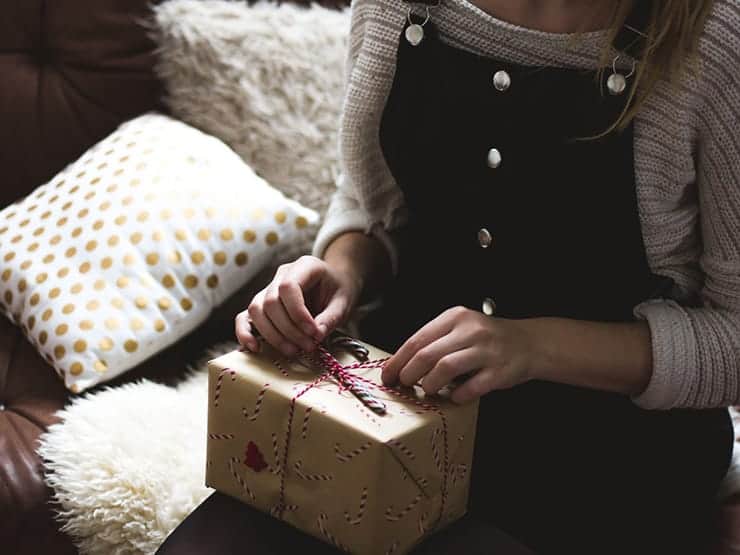
By limiting your gift list, you’ll cut your spending and stress, and save yourself time. It’s also a green choice: reducing our consumption is one impactful way we can be more responsible consumers.
But how exactly do you cut down your gift list? Here’s how we broached this sometimes-touchy subject and negotiated ‘gift truces’* with our friends and family.
*Thanks to Chris at TicTocLife for the idea to call our no-gift negotiations ‘gift truces’—I love it!
Start with one conversation
If you’re unsure of how others feel about going giftless, start by initiating the conversation with one person. We started by telling one friend that we wanted to simplify Christmas and save everyone time and money.
Instead of gifts, we wanted to focus on the things that truly brought us joy: spending time together and doing things for each other throughout the year. Our friend was happy to go along with our suggestion, agreeing that we all have more than enough stuff.
After that success, we approached other friends and family members with the same request. To our happy surprise, everyone was immediately on board. In less than an hour of messaging, our Christmas list was cut by a third!
If you’re not sure how to start a conversation like this, below is an actual message I sent to my cousin. Feel free to use it verbatim if it works for you:
Hi Jen,
How are you? We’re looking forward to having lunch at your place next month! As we prepare for the gathering, we’re wondering if we can make a request?
It’s the same request we’ve made to other family and friends, and we hope you’ll be okay with it: in an effort to simplify Christmas, we’re opting not to exchange gifts.
We’ve found our giftless Christmases to be such a relief for everyone. It saves time, money and energy, which we can then redirect to more quality time together. (Not to mention: it also lightens our footprint on the Earth!)
I hope this doesn’t come off as presumptuous—maybe you hadn’t planned to exchange gifts anyway! But we prefer to be upfront.
We’re looking forward to seeing you again and catching up. Let us know what you think of our green Christmas idea.
Love,
Chrissy
2. Eat sustainably
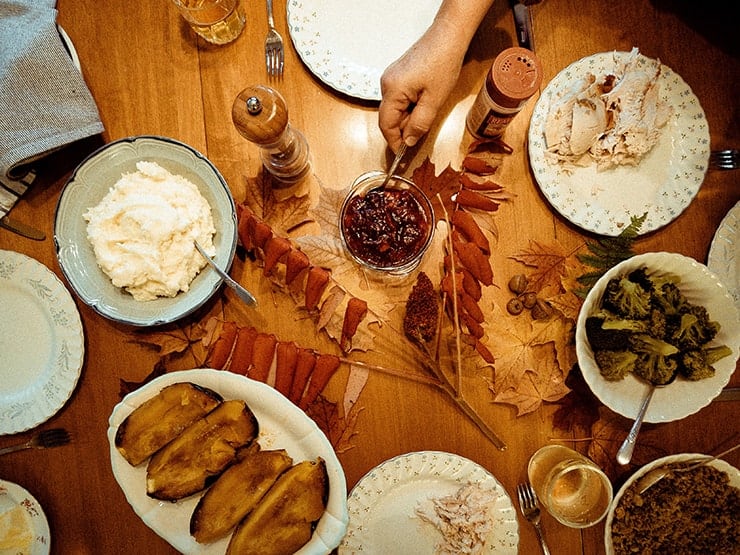
When I originally wrote this post, I neglected to include a major topic—holiday food. My friend Chris Istace at Mindful Explorer pointed this out to me in a tweet:
“PLEASE carefully consider your groceries for all those Holiday meals. Where will you source your food? Will you try plant based? Is it local? How much will you make? Average Canadian home wastes 140kg food per year.”
Food waste and more-sustainable eating is something my family is paying increasing attention to. Here are some simple, actionable ways to make your holiday meals greener:
Buy local
When possible, try to buy fresh, local ingredients that haven’t been flown or shipped thousands of miles. Even better—buy local food from small, local stores near home or work.
You not only save emissions from driving to a big box store, but also provide jobs and a livelihood for those who own and run these small businesses.
Try plant-based
My family and I have been pleasantly surprised by how easy (and tasty) it is to substitute tofu or TVP (texturized vegetable protein) for meat. You don’t even have to go 100% meatless—subbing a portion of the meat still makes a huge impact.
Alternatively, plant-based meat substitutes are an easy way to create greener versions of favourite dishes. Or, make meat a side dish and focus instead on dressing up classic meatless sides (stuffing, mashed or scalloped potatoes, and grilled veggies).
Prevent food waste at home
As my friend Chris mentions, the average Canadian household wastes 140 kilograms (308 pounds) of food every year. Out of that 140 kg of waste, it’s estimated that 63% is avoidable. It’s time for us to do better and aim to get as close to zero waste as we can.
Love Food Hate Waste is a public awareness campaign that’s helping with this. Launched in 2007 in the UK, they aim to reduce food waste through practical, everyday actions. (Love Food Hate Waste has also spread to other countries, including Australia, New Zealand and Canada.)
Each website includes a wealth of ideas to help you to combat food waste and get creative with the food you bring home. (The Canadian site even includes a section just for holiday tips!) By planning ahead and making small changes, you’ll not only help the Earth, but also save money and time.
Reduce retail food waste
You can also help to reduce food waste at the retail level by shopping through services like Flashfood or Imperfect Foods. These companies help retailers sell their near-expiry or blemished groceries at a steep discount.
Consumers benefit by saving money, helping the planet, and getting the opportunity to try new ingredients. Why not check out one of these services this holiday season? You could end up creating a delicious new Christmas dish—for a fraction of the price!
Related: read my detailed Flashfood review and use my referral code, CHRIWAMP to receive a $5 credit!
Make your groceries (and leftovers) last
One often-overlooked area of food waste is food that’s lost due to improper storage. When we don’t optimize how we store our ingredients and leftovers, they can spoil sooner and lose some of their nutritional benefits.
In How to Save $40 a Month With Three Easy Fridge Hacks, I share some easy ways to improve your food storage—preventing spoilage and waste. These tips help my family save over $40 per month in energy and food costs!
Since most of us purchase larger-than-average amounts of food over the holidays, it’s the perfect time to get our fridges ready to store all that food!
3. Make a list

Now that you’ve minimized the number of gifts you’ll need to buy, it’s time to make a list. There are so many benefits to creating and maintaining an annual Christmas gift list. For example, my list helps me to:
- Stay organized and save time;
- Save money by planning ahead and buying on sale;
- Keep track of what I still need to purchase;
- Remember gifts I purchased on sale last year;
- Remember where I stored those gifts;
- Reuse gift ideas from last year;
- Add notes for next year;
- Prevent over-buying (I no longer need to keep just-in-case gifts on hand);
- Prevent duplicate gifts (whether from year-to-year or for different people);
- Never forget someone (doctors, teachers, etc.);
- Avoid last-minute shopping runs;
- Minimize shopping trips (which saves time and gas).
I keep my list in Evernote so that it’s easy to update, and always with me. Wherever I am, I can pull up the list on my phone to see what I still need to buy. (No more lost slips of paper!)
If you’ve never used a Christmas gift list, I highly suggest you give it a try. I’m confident it’ll help you have a greener Christmas by saving you money, gas, and time!
4. Get creative with kids’ gifts
Our extended family loves getting gifts for the kids—and who could blame them? Seeing those little faces light up is so much fun! But we have a huge family and always end up with a tsunami of gifts on Christmas and birthdays.
As appreciative as we are of our relatives’ generosity, we knew we had to change things. Here are some of the ways that we and our family make gift-giving to the kids greener:
Offer an experience
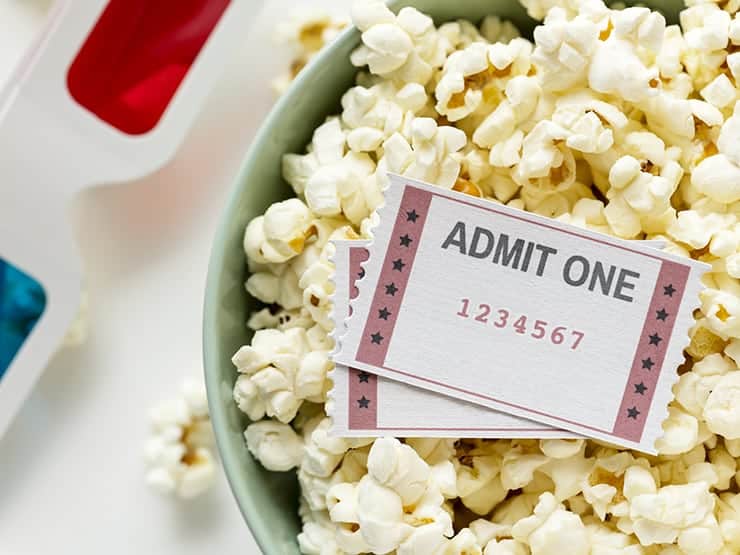
My sister has done a wonderful job of this with her kids. Instead of giving them physical gifts, she lets each of them pick a fun outing or experience of their choice.
One year, her daughter’s pick was to ride around the mall on one of those big, ride-on stuffed animals. This is something my sister normally wouldn’t pay for, but it was a perfect choice as an experience gift!
Other experiences her kids have asked for include: going to a trampoline park, seeing a movie at a theatre, or a having a family board game night. All of these choices are affordable or even free ways to spend time together.
And what better gift is there than having quality time to build memories as a family?
The key is in the ‘why’
While my sister’s kids are mostly on board with experiential gifts, they’re still kids! They do question it at times and wonder why their family chooses experiences over stuff.
This is when my sister and her husband explain the why of their choice. In doing so, her kids understand that buying less stuff means more money, time, and energy saved. And in turn, they can direct those precious resources to things they truly value—like family outings, travel, and even FI.
They also discuss how important it is that they do their part to reduce their impact on the environment. This was a pretty easy sell for her kids, whose generation is very in tune with the crises facing our planet.
Once they’re reminded of these whys, it’s not hard for them to go back to being happy with their experience-based Christmas gifts.
My guilty secret
I have a guilty secret to share: I don’t gift experiences to my kids! Exciting Christmas mornings spent opening physical gifts is a big part of our family culture, and it’s hard to make the shift.
However, I’m very inspired by my sister’s experience and hope to move towards giving my kids experience gifts in the future.
Buy on sale and create your own ‘store’

Another creative way to save and go green with kids’ gifts is to buy their gifts on sale, then stash them to create your own ‘store’. I know it sounds a bit weird, so let me explain:
Some of our relatives really enjoy giving physical gifts to our kids. Since it’s so meaningful to them, we want them to have the opportunity to give our boys a special gift at Christmas.
But we’re frugal and hate to see our relatives paying full price for these items! So our family has a system where the parents of the kids buy their desired items when they spot a sale. Then the relatives buy the gifts directly from the parents to give to the kids.
This saves our relatives money and time, and our kids get gifts that they really want. There’s also less impact on the Earth since we don’t end up with a pile of unwanted or inappropriate gifts.
Everyone wins!
Ask for cash

In our family, cash is a welcome gift option. For the gifter, it’s easy and convenient. For the giftee, it offers flexibility (especially for tweens and teens, who may want to save up for larger items).
This gift money is also how our kids have steadily built sizeable investment accounts. Since they spend so little of it (with a portion going to charity) there’s always a large chunk of cash leftover. And what does a good FI-minded parent do with excess cash? Invest it, of course!
As our parents did with our gift money growing up, we’re slowly building nest eggs for each of our kids—largely from these gifts of cash. Instead of a pile of stuff, they have a steadily-growing pile of investments.
I realize this may sound crass, and may even be insulting to some. But our relatives are like-minded when it comes to money. They actually appreciate that their gift money is going towards something more valuable than the latest video game!
That’s second generation FIRE in action!
Ask for gift cards
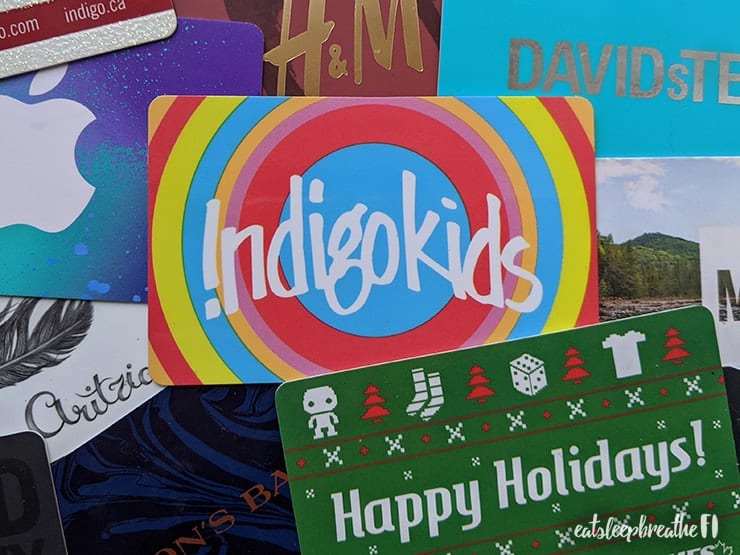
For those who are uncomfortable with cash gifts, gift cards to favourite stores are a good alternative. They’re convenient for the gifter and easy for the giftee to spend—another win-win for everyone!
Jump to my Give greener gift cards tip to learn how to make gift card gifting greener.
Buy used

This is another option that may not fly with your family, but it’s such a great money and Earth saver that I have to mention it: I always start with Craigslist when shopping for my kids’ Christmas gifts.
While this may sound odd or icky, hear me out! I do this because kids generally couldn’t care less how their gifts are packaged or if they’re brand-new. As long as it looks decent and is in working order, they may not even notice that the item is used.
Here are some of the benefits I’ve seen from giving my kids used gifts:
Huge money savings
Used items are typically a fraction of the cost of new ones—even when they’re in like-new condition. That means more money in your wallet (or the ability to afford more gifts for your kids).
Affordable unique or rare items
Sometimes, the gifts my kids asked for are no longer sold in stores (e.g. certain Nerf guns or limited-edition LEGO sets). Instead of paying a premium for these discontinued items on eBay, I searched Craigslist for them—and almost always find what I’m looking for.
Less consumption
Since I’m purchasing something that’s already been manufactured, I’m preventing more of that item from being made. This is a very good thing since decreasing consumption is an impactful way to help the Earth.
Less landfill waste
Buying used also helps to prevent otherwise-good items from being sent to the landfill. The more we support the used marketplaces in our community, the more incentive there is for people to sell, rather than toss their unwanted items.
5. Gift mindfully
While the best choice is to minimize gift-giving, it can be difficult to cut out all gifts. Instead, we can be more mindful when gifting to others.
Let’s quit buying those junky token gifts and consider some greener alternatives:
Give experiences

Experiences are a great alternative to giving yet another mass-produced doohickey. The ideas for experience gifts are endless and are easy to personalize! To get you started, here are some favourite experiences that we’ve given or received:
- Admission tickets or annual membership to a local attraction or museum.
- A family fun pass (like Kidsworld).
- A homemade coupon book of frugal outings to ‘cash in’ all year round.
- A gift certificate to a pottery studio.
- A couple of rounds of glow bowling.
- Tickets to a local sports event.
More experience-based gift ideas
- Create Memories, Not Garbage: An amazing website from Metro Vancouver filled with unique gift ideas and tips for a green Christmas.
- 22 Experience Gift Ideas for the Holidays: A great article from Jessica at the Fioneers about giving experiences instead of things.
- How to Avoid a Transactional Christmas: In this excellent post, Maria shares some helpful ideas to avoid a Christmas based on meaningless lists and gifts.
Give consumables

Gifts of food and personal care items are always a reliable gift option. They also make for a greener choice because they’ll be eaten or used up in short order! That means no lingering clutter or yet another item to purge one day.
Even if the item isn’t needed or wanted, it’s unlikely that it’ll end up in the landfill. That’s because there’s never a shortage of people who’d love to eat or use up these items on others’ behalf!
If you’re keen on making consumables yourself, this gift option can also be a good way to save money. Treats, soaps, and scrubs often cost pennies on the dollar to make at home.
DIY gifts also allow you to choose greener packaging. Instead of adding more plastic to the waste stream, you could gift cookies in a compostable paper box. Or package homemade soap in a reusable cloth bag.
Whether homemade or store-bought, consider consumable items. They can be a lovely, clutter-free alternative to generic token gifts.
Give green

Green gifts can be a fun, easy way to help others live more sustainably. Below are some green gifts I’ve given and were big hits:
- Stainless steel bottles.
- Stainless steel straws.
- Reusable fabric shopping bags.
- Reusable mesh produce bags.
- Pocket-sized stainless steel cutlery.
- Wool dryer balls.
- Beeswax food wraps.
Your green gift may even inspire your friends and family to incorporate more green practices into their life!
Give greener gift cards

I’m not sure how this is allowed, given the state of our planet, but most gift cards are made of plastic. Even worse—they’re made of laminated plastic, which makes them hard to recycle.
Gift cards don’t need the durability of plastic like credit cards do. We just don’t use them as much or keep them as long. In my opinion, ALL gift cards really should be made from recyclable cardstock!
Unfortunately, we can’t control the powers-that-be who decide what to make gift cards out of. But we can choose greener options whenever possible. Here are a few suggestions:
Buy gift cards made of recyclable cardstock
- I’ve come across a few companies that sell paper gift cards: Apple iTunes, Starbucks, Roots, Netflix, and MEC.
- I’ve mostly found these paper gift cards in the gift card section of grocery stores.
- It can be hard to tell if a gift card is made of paper or plastic unless you can touch it. (I’m not sure why these companies don’t tout the fact that their cards are plastic-free—to me, it’s a selling feature!)
Opt for print-at-home gift cards
- Many online retailers offer this option.
- Some retailers (Amazon comes to mind) thoughtfully design their printable gift cards to be folded into a nice card.
Opt for digital gift cards
- This doesn’t work for face-to-face gift exchanges, but it’s a great option for gifts to out-of-town friends and family.
Reuse plastic gift cards
- Save gift cards that you’ve used up, then refill them to gift to others.
- Order consignment gift cards from sites like CardSwap or Gift Cards Wild.
Give practical items
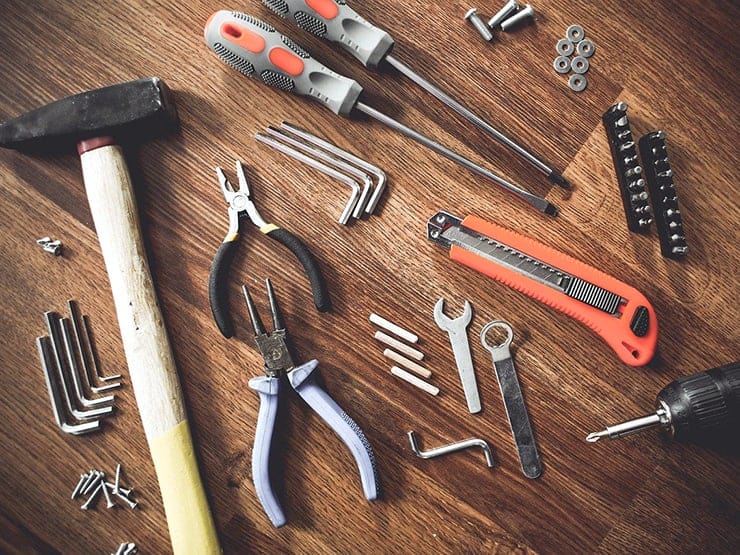
When gifting practical items, chances are they’re needed and will be put to good use. This means less clutter and less junk going to landfills. (Especially if you purchase higher-quality items.)
Below is a list of well-received practical gifts that we’ve given to others or received ourselves:
- Tools.
- An Instant Pot.
- A cast-iron or carbon steel wok.
- A nice set of chopsticks.
- A wine aerator.
- Themed/crazy/character socks.
- Non-skid fuzzy socks.
- A cozy scarf (homemade if you can swing it).
- A warm toque/beanie (this would also be extra-special if homemade).
- Next-size-up clothing for kids.
- Pajamas.
- Fuzzy slippers.
- A useful or helpful book.
- A custom-assembled car safety or earthquake preparedness kit.
Give digital gifts

Digital gifts consume a fraction of the resources of physical gifts. By giving digitally, you’re cutting out many streams of resource-sucking processes. (Manufacturing, packaging, shipping, storing, displaying, wrapping, and disposal.)
Digital gifts are also perfect for last-minute gifts since you can purchase and gift them almost instantly. Plus—there’s no need to ship them, which saves you money and minimizes the carbon footprint of your gift.
Here are some digital gifts that we’ve given (or that I would love to receive):
- E-books.
- Audiobooks.
- Music.
- Movies.
- Videogames.
- Apps.
- E-codes for in-game videogame items.
- An online course.
- Electronic gift cards.
- A subscription to an entertainment service (Netflix, Disney+, Spotify).
- A subscription to a productivity tool (Headspace, Evernote Premium).
- A subscription to an online newspaper or magazine.
Give gift receipts

Wherever possible, ask the cashier to print a gift receipt when purchasing gifts. It’s so easy to do and costs nothing, but so many people forget this extra little step!
Gift receipts are a thoughtful way to ensure your gift recipient can get exactly what they want. If they need a different size or colour, or just don’t like the gift, they can easily exchange it for one that suits them better.
This saves everyone some awkwardness and also means one less thing going to the donation bin or landfill.
Give to charity

Gifting to charities in the name of the person you’re gifting to is a lovely idea… in theory. In practice, it’s slightly awkward. You’re essentially swapping your gift to someone with a donation to a charity of your choosing! I’ve never felt right about this, so have never given a donation as a gift.
But I’ve recently discovered a better option: charity gift cards. You can purchase them from organizations such as Canada Helps, Charity Choice (US) TisBest (US) or Charity Vouchers (UK).
When you purchase charity gift cards, your giftee will be free to choose who to donate to, and you’ll get the tax receipt. I think it’s a thoughtful, green gift and a win-win for everyone.
Bonus: make the gift extra-green by printing the gift card at home and gifting it in a recyclable paper envelope. This reduces plastic use and carbon emissions from shipping the physical card.
6. Go green with your wrapping
It’s been years since I’ve needed to buy wrapping paper or Christmas gift bags. How have I managed to pull this off? With green wrapping, of course!
Here are some of my favourite ways to go green with our gift wrapping:
DIY reusable cloth bags

A coworker once told me how her family used old pillowcases as Christmas gift bags. I loved the idea and thought it was ingenious. But instead of repurposing old pillowcases, I opted to make my bags using pretty Christmas fabric. (I wasn’t as aware of sustainability in my younger years.)
While my DIY bags weren’t as eco-friendly as old pillowcases would’ve been, they were a relatively frugal choice: I waited for Boxing Day so I could purchase the fabric at a 50% discount.
It’s been close to 20 years since I made those bags, and they still look great. We pull them out every Christmas to ‘wrap’ our gifts… and every year we’re so grateful I made them! Not only are they pretty under the tree, but they’re also a huge time saver. Since I sewed the bags with drawstrings, it takes mere seconds to bag a gift and tie it up!
I also love that we’re not adding piles of paper to the recycling bin or buying hard-to-recycle laminated paper gift bags. Reusable cloth gift bags are definitely a green choice! (But try to make them greener than I did by upcycling old fabric instead of buying new.)
Reuse paper gift bags

When we receive paper gift bags, we keep and reuse them. The slightly worn or wrinkled ones go to gifts for family (they don’t care because they all do the same!) And the more-pristine bags are reserved for gifting to friends and co-workers.
I also made some stickers that say, “I’m going green by reusing this gift bag. Please consider doing the same and passing on this bag with your next gift.”
I stick these to the bottom of my reused gift bags to encourage others to use them over and over again. I’m not sure if this has ever happened… but I can hope!
Choose 100% paper gift bags

If I ever need to purchase paper gift bags, I look for the ones that are just plain paper, without lamination. That’s because lamination is a thin plastic film that’s fused to paper. This makes the paper very difficult to recycle… which means more waste in the landfill.
100% paper bags might be less durable, but at least they’re fully recyclable or compostable at the end of their life. Additionally, Chris Istace at Mindful Explorer points out an important distinction:
“Use ‘100% post consumer recycled’ paper bags… if recycling is to have value as an industry we need to use items made from recycled materials. Plus we save the need for new wood fibre.”
Put a (used) bow on it

As with laminated gift bags, I collect and save those poofy plastic bows we receive with our gifts. These things last forever and can be used over and over if you add a fresh loop of tape to the back.
They can make a gift bag or paper-wrapped gift look extra special. Or they can be the perfect, minimalist gift wrapping for large, bulky, or odd-shaped gifts—just stick a (used) bow on top, and you’re done!
By reusing these bows, I’ve never had to spend money on them, and I’m keeping them out of the landfill.
7. Go green with your Christmas cards
As nice as it is to give and receive Christmas cards, we should all try to be more mindful of the materials they’re made of. Most of us don’t realize that glitter, foil, or other accoutrements make Christmas cards difficult or impossible to recycle.
The paper that could’ve been recycled becomes more landfill waste. What a shame—the 5% of a card that’s not recyclable ends up wasting the 95% that is. Here are some tips to minimize the environmental impact of the cards you give and receive:
Mindful card giving
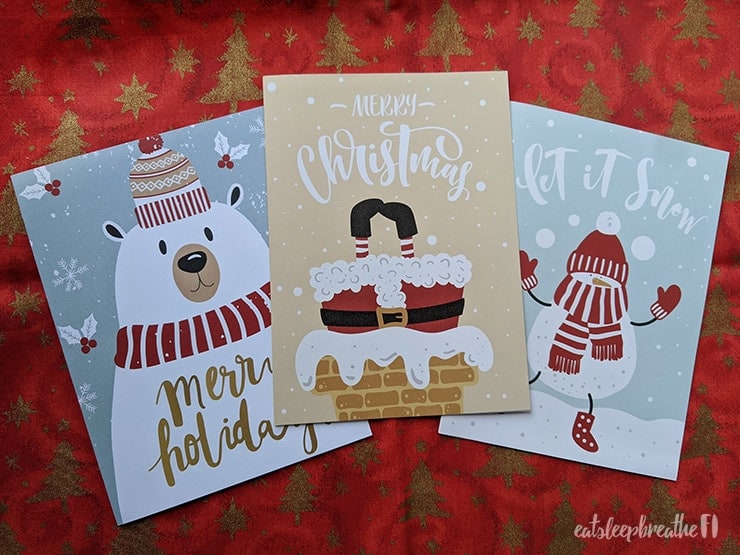
Consider these greener options before making your Christmas card list:
- Minimize the number of cards you send out.
- Choose 100% paper cards (avoid embellishments like glitter, foil, and metal/plastic accents).
- Choose 100% paper envelopes (avoid the ones with unrecyclable foil liners).
- Buy smaller cards.
- Give gift cards in an envelope and no card (or insert a small note with the gift card).
- Send digital cards instead.
Mindful card receiving

Don’t just throw out those beautiful cards you’ve received! Here are a few ways to deal with them more sustainably:
Recycle old Christmas cards the right way
You could go through the tedious process of removing only the unrecyclable components from the cards, then recycling what’s left (I do!) But I’m a frugal eco weirdo who’s happy to take on silly tasks like this. Most people aren’t.
A simpler solution is to cut off and throw out the decorated front half of the card then recycle the (usually) 100% paper back half of the card. Or, instead of throwing out that pretty decorated front, see the next tip.
Upcycle old Christmas cards
There are plenty of creative ways to give those beautiful (but unrecyclable) Christmas cards one more use. My personal favourite is to trim them down to use as next year’s gift tags, but there’s a myriad of other ideas:
- Christmas card crafts from Hallmark (so many gorgeous ideas here)
- Tiny gift boxes (video)
- Donate them to charity (also includes other great ideas and recycling tips)
- Bookmarks (an easy gift that kids can make)
- 51 epic ideas (too many amazing ideas to list—check them out for yourself!)
- Even more beautiful ideas (I especially love the jar toppers and gift box bling)
- A wreath (I like these instructions because they don’t use non-recyclable materials)
These crafts will keep your cards out of the landfill and save you money on wrapping supplies. Also, some of them are beautiful enough to give as gifts (that cost you almost nothing!)
8. Go green with your shipping

Even before COVID, online shopping was on an upward trajectory. That’s both good and bad. It’s good because it saves us from having to drive all over to get the holiday gifts and supplies we need. But it’s also bad because someone still has to do the driving!
Many of us are unaware that the highest-polluting part of our packages’ journeys is what’s known as ‘the last mile’:
“The last mile problem comprises one of the most costly and highest polluting segments of the supply chain in which companies deliver goods to end customers.”
– Jay R. Brown and Alfred L. Guiffrida at researchgate.net
To make package shipments as green as possible, we can do our part by minimizing the last mile problem. There are a couple of ways to do this:
Ship to a nearby post office or package locker
By doing this, you can help make the last mile greener since you’re the one who decides how to cover that last mile.The greenest options would of course be going by bike or on foot.
However, even going by car could be relatively green if you plan to pick up your package on the way to or from somewhere else. (Just don’t negate the benefits of this option by making a special trip in your gas-powered car to pick up the package!)
Choose slower shipping options
Our one-click, same-day delivery culture has trained us to expect online orders at our door NOW. Problem is, same-day deliveries give shipping companies fewer opportunities to group items and orders for the last mile (and every part of the journey).
This results in more deliveries, more often. We need to put an end to this—all these extra deliveries are killing our planet. (Just one of the reasons why I abhor Amazon Prime!)
By selecting slower shipping options, you not only save money, but also reduce the number of trips a shipping company has to make to your neighbourhood. As an added bonus, you’ll also train yourself to be more patient (which is also good training for the FI journey)!
9. Plan for next year
I always find it most effective to start planning for next year soon after the holiday madness has passed. That way, you won’t forget important details and changes you want to make.
Here are some of the things I consider when planning for next year’s Christmas:
Budgeting for Christmas

We all know Christmas comes around every year, yet few of us actually plan ahead and save up for it. I was guilty of this myself—until I discovered YNAB and learned there was a better way!
At YNAB, they suggest including a budget category just for Christmas. You start by estimating an amount you’ll need to spend for Christmas, then break it into a monthly amount. (Even better: tally up what you spent last year, then base it on that number.)
Next, create a Christmas category in your budget. Enter the amount you need to set aside each month, then watch the balance grow. When December rolls around again, you’ll have a pot of money ready to use for Christmas!
Note: you could also set up a recurring transfer into a savings account to do the same thing. (The Savings Plus Account from EQ Bank is great for this. You can add up to four sub-accounts so you can easily save towards big expenditures.
Other considerations

To further fine-tune our plans, I also review the following before and after the holidays:
- Gifts we’d like to add or remove from our gift list.
- Expenses we could cut back on.
- Sales we should watch for throughout the year.
- Social events we’d like to add, remove, or change.
Planning ahead is one of the best ways to save money and avoid buying decisions based on convenience rather than sustainability. So get those budgets and lists started now, and make next year’s Christmas your greenest yet!
Summary
There are so many easy, approachable ways to have a green Christmas—and there’s no need to sacrifice any fun or enjoyment to do it!
- Limit gifts: Ask your family and friends to consider going giftless. You’ll save money, time, and stress—and have more energy to focus on quality time together.
- Make a list: Get clear on what you need to buy, and for whom. This will save you money, time, and stress while reducing your consumption and carbon footprint.
- Get creative with kids’ gifts: Experiences, cash, gift cards, or used items are more-sustainable alternatives to giving kids yet another brand-new toy.
- Gift mindfully: Instead of buying junky token gifts, get mindful with your gifting. Doing so will help to minimize the impact of your gifts on the planet and your wallet.
- Go green with your wrapping: Reusing and upcycling can reduce or eliminate your need for new wrapping materials and send less waste to landfills.
- Go green with your Christmas cards: Most of us aren’t aware that the pretty cards we give and receive are not recyclable. Learn more, then seek out more-sustainable alternatives.
- Plan for next year: Save up for stress-free Christmas spending, and consider other ways to save money and time next year.
I hope these tips for a green Christmas have opened your eyes. There are so many easy, simple alternatives to conventional gifting, shopping and wrapping. If we all make a few small changes, we’ll be helping to ensure many generations of green Christmases to come!
Got any green Christmas tips?
Do you have other green tips that I’ve overlooked? Did I get anything wrong? Tell me in the comments so we can all learn and have an even greener Christmas next year!
Support this blog
If you liked this article and want more content like this, please support this blog by sharing it! Not only does it help spread the FIRE, but it lets me know what content you find most useful. (Which encourages me to write more of it!)
You can also support this blog by visiting my recommendations page and purchasing through the links. Note that not every link is an affiliate link—some are just favourite products and services that I want to share. 🙂
As always, however you show your support for this blog—THANK YOU!





23 Comments
Chris @ Mindful Explorer
December 13, 2019 at 12:26 pmOne of the best lists I have seen on the web Chrissy ! You knocked it out of the park on this one. My only addition would be sensitive to buying excessive food or making too much food for all those festive suppers and get togethers.
“63% of the food Canadians throw away could have been eaten.
For the average Canadian household that amounts to 140 kilograms of wasted food per year – at a cost of more than $1,100 per year!”
https://lovefoodhatewaste.ca/about/food-waste/
The Twin
December 13, 2019 at 2:11 pmChris, that’s a fantastic addition to this list. Food waste has a bigger footprint than most people realize, and that $1100 is a pretty compelling reason for all of us to be more mindful of food waste during the holidays and throughout the year.
Chrissy
December 15, 2019 at 11:11 pmChris: you’re a leader when it comes to sustainable living, so your comment means a lot!
Thank you for the suggestion to mention food waste. This is a major issue, and one that requires an entire section of its own. I’ll cover it when I update this post next year. 👍
The Twin
December 13, 2019 at 1:57 pmWhoa, when you said epic, you meant it! Like Chris said – you knocked it out of the park!
As your kindred “frugal eco weirdo”, I love, love, love how this list is so earth-friendly. 🌎 It really doesn’t take much to make the Christmas season less wasteful and excessive. And, it just feels really good to have a smaller holiday footprint!
I’m so delighted that my kids’ experiential gifts are part of the list! 😬 I hope other readers are inspired to go and seek out their own cool family activities to do together. Memories are one of the few gifts that truly last a lifetime. 💕
Chrissy
December 15, 2019 at 11:31 pmThanks for the comment, sis! Much like being on the FI path, it can be a lonely road when trying to live more sustainabley. Most people don’t get our weirdness!
I’m lucky to have others like you and friends in the online community to keep me inspired and motivated.
We’ve got a long road ahead, trying to heal our planet. All of us need all the support we can gather.
GYM
December 16, 2019 at 12:09 amSuper comprehensive! Our Christmas tree looks bare because we don’t have many gifts to give our kids and each other. I love having gift receipts (e.g. if it’s for our kids) because I 99% go back and exchange things and use the ‘money’ to buy a gift for someone else that we need to buy for, and get something smaller for our kids.
Chrissy
December 19, 2019 at 11:14 amI always appreciate gift receipts. They just make sense! I find it’s especially helpful for kids’s clothing gifts (relatives and friends often get the sizing wrong)!
Ana
December 16, 2019 at 7:44 amSuch a good read! Love all your tips for simple green living. My family is very similar to yours in our practical ways of gifting and keeping costs down. My challenge now is with my kids who want the latest pricey gadgets- phones, tablets, air pods, you name it. Fortunately, they enjoy the experience gifts, too. Trying to find a balance 🙂
Chrissy
December 19, 2019 at 11:16 amThanks for the comment, Ana. It’s tough finding a balance with kids, especially as they get older. The gadget-y gifts definitely move higher on the list, and the price tags get bigger!
Kris
December 16, 2019 at 4:41 pmIt was great reading this Chrissy, thanks for writing this up!!
For families, we simply give them one gift instead of individual gifts to each family member. It usually consumables like a box of cookies, chocolates or a tin of popcorn the whole family can enjoy. Also attached with that gift is a customize greeting photo card showing pictures of our family from the past year. We usually buy a pack of 50 at Costco so our family and friends can hang it on their fridge or their photo collection.
If we want to give anyone a gift for Xmas, MwC has a whole bunch of gift wrapping paper, gift bags and ribbons she saved from the past Xmas gifts we received and reuse them gifting presents. If for some reason the present is too big for the gift wrapping paper/bag, we just make one out of paper bag and put a ribbon around it.
In terms of receiving gifts, we love gift cards. I know many don’t view it as creative or thoughtful but it provides flexibility for us to buy anything at a particular store or even better, an Amazon gift card(we prefer the digital version).
Chrissy
December 19, 2019 at 11:30 amI like the idea of a single consumable gift for each family—it’s simple and fuss-free! It’s fantastic that MwC keeps and reuses old gift wrap. Most people can’t be bothered, and just toss everything. I know it’s not a huge money or Earth saver, but I believe every little bit helps. I agree that gift cards make great gifts. I find if we that put them in a card with a personalized message, that helps to make it more thoughtful.
I hope you and your family have a Merry, green Christmas, Kris! Less than a week to go—yikes!
Shaidah
December 20, 2019 at 9:09 amLoved this!
As we were writing xmas cards this year, we realized our stock is running low. As soon as xmas is over, I will be trying to find some clearance cards at a third of the price- planning for next year!
We found a 3 foot xmas tree with all the decorations in the attic when we bought our house. We have been using it for 15 years so far and have been adding ornaments when they have been gifted to us. That is the extent of my xmas decor. I don’t like storing stuff 🙂
I have friends coming for dinner tonight and I let them know to not bring anything as I have enough stuff and am trying to work on becoming a minimalist. They responded with how inspiring I am to them.
An easy gift to make is fudge. I have made a few batches already and have been giving out fudge. As soon as I perfect how to make the beeswax wraps, I will give the fudge wrapped in one of those 🙂
Chrissy
December 22, 2019 at 9:34 pmI’d like to see this abandoned Christmas tree. 😁 I hope you’ll still have it up when we come over next week!
I love that your friends were inspired by your request to go giftless. I hope they’ll be inspired enough to share the same message with their family and friends. Perhaps with enough of us going giftless, we’ll one day see a less consumerist Christmas? One can hope!
I am beyond impressed that you’re trying to make your own beeswax wraps! That is just too cool. You never fail to impress me with your resourcefulness and creativity.
Anne@readysteadyretire.com
December 21, 2019 at 3:37 amHi, brilliant, thoughtful blog post. Some excellent ideas. Never thought of just recycling part of Christmas card. Definitely a more minimalist Christmas for our family this year, though as my kids are older the gift they seem to appreciate most is money!!
Trying to really cut down on items in house and continue to seriously declutter and donate to a local homeless Charity Shop.
Why did I buy all these unnecessary items
Greetings from the UK.
Anne
Chrissy
December 22, 2019 at 9:27 pmHi Anne, thanks for commenting all the way from the UK!
Our kids also tend to ask for money as they get older. It’s definitely a convenient, practical gift!
As for decluttering, I’m beginning to think I should do it in October so that when the holiday sales hit, I’ll have no desire to shop and reclutter my home!
Thanks for coming by. I’ll be sure to check out your blog too!
drplastickpicker
November 26, 2020 at 8:49 amWhat a treat! I saved the blog post for this holiday morning to read. What a beautiful post and I love the message. I’ve going to post this on my personal facebook page for my friends. I was thinking how important your blog and instagram handle is as well. The best things in life are eating, sleeping and breathing. I was trying to get to sleep last night and it dawned on me that your blog name is so fundamental. Good sleep. Good food. Clean Air. It’s what we all need. Hugs from So Cal.
Chrissy
November 26, 2020 at 9:04 pmHello, my lovely eco-warrior friend! You never fail to inspire and lift me up with your posts, thoughts and comments. Thank you for reading, sharing, and all that you do.
You know, I never thought about my blog name that way, but I LOVE the extra meaning you’ve ascribed to it. Now I see it and my logo in a whole new light, and how it’s perfectly suited to my big aspirational goal for spreading the FI message: to save our planet and its people. ♥🌎
Dan
November 29, 2020 at 4:45 pmExcellent tips and reminders in here. As a naturally frugal & practical-thinking person I love both negotiating “gift truces” with as many people as possible, and giving useful gifts like tools and household items that I feel certain won’t be deemed ‘junk’ anytime soon.
Also, super stoked to read your family is so open to plant-based meals & substitutes! Like you said, even a partial substitution makes a big difference. The huge environmental impact of animal products isn’t something a lot of people are fully aware of.
Cheers from Up North.
Dan
Chrissy
December 1, 2020 at 5:09 pmHi Dan—I’m honoured that you read my post and have such nice things to say about it. (I know how green and frugal you and Ellie are.) Ha, “gift truce” is a perfect term. I’ll have to remember that if I need to negotiate more truces in the future!
We’re still learning when it comes to plant-based meals. Being Asian, we already “speak” tofu, but I’m learning to be more creative with veggies and getting my family used to making meat a much smaller portion of their meals. It’s a slow process, but I feel good every time we do just a little bit better. Hopefully, eating this way will eventually become the norm and not just the exception.
Teresa
November 30, 2020 at 4:40 pmI really like the Green Christmas tips! When I started as a realtor 30 years ago, I used to drive around and give calendars and gifts to our clients. As the number grew and time was limited, I contacted my client list and asked if they gave then the option to continue receiving the gifts or have me make a $1,000.00 donation to the Vancouver Bank. Every one of my clients chose the latter and voila! It was a great way to make Christmas special for more than just a few. Many other professionals followed my example and it was a good feeling to have started a new way to celebrate.
Chrissy
December 1, 2020 at 5:13 pmHi Mom—I never knew you gave your clients that option! How creative, and what a nice way to repurpose your spending and marketing efforts. It’s amazing that others followed your lead and did the same. We can make big differences just by changing our own small actions.
Chris@TTL
December 6, 2020 at 11:44 amChrissy this is one heck of a rundown on green Christmas gift ideas, and really, just efficient giving ideas in general! Great job.
I especially enjoy the idea of setting up a “store” amongst your gift-giving circle (friends/family) for the children to be able to pick out items that were purchased on deep discounts over the year. Kids get to pick what they want and it’s done so at discount prices.
Chrissy
December 6, 2020 at 3:05 pmHi Chris—this post was basically a compendium of 42 years of gift-giving practices stored up in my brain, ha ha. I love that I can share the things I’ve learned and that others have taught me. It’s the hive mind in action! Hopefully, green thinking like this will spread and become more and more mainstream.